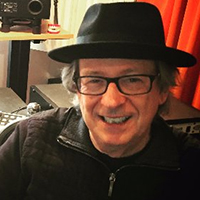For recording electric guitars, I’ve been using a “trick” with the figure-of-eight Royer R121 ribbon microphone.
I like this method because it increases the “coupling” of the low-end frequencies and air of the speakers to the mic, and I also find it great for loud clean sounds and cruncher rhythm parts, especially low-tuned guitar parts where you want as much “sturm und drang” (storm and drive) as possible.
I line up dual 4 x 12 Marshall cabinets directly facing each other as close as six inches. I put the Royer in between the two cabs in the exact middle so that each lobe is aimed at an opposing cabinet.
The two lobes of the figure-of-eight pattern are 180 degrees out of phase from each other.
The big trick is that you have to flip the polarity of one of the speaker cabinets so it is out of phase with the normally wired cabinet.
To get these two cabinets to “push-pull” together, I made a foot-long jumper cable with a female 1/4-inch jack at one end and a regular male 1/4-inch plug at the other.
Just solder the tip of the female to the sleeve of the male and the tip of the male to the sleeve of the female. It’s a polarity flipper!
Both cabinets must be connected to the same head – I like 100-watt Marshall tops.
It’s important not to use two amps because there might be a phase flip (between them) other than 180 degrees. You should investigate if the polarities of the speakers inside the cabinets are all the same.
Some manufacturers intentionally flip the polarity of the individual speakers to get a particular overall sound character from the cabinet.
If that is the case and you don’t want to rewire them, figure out which speaker are wired the same way in both cabinets and mic them as a pair with the Royer.
You can get a lot of different guitar sounds, by varying how close the speaker cabinet are to each other, where you put the mic, and which pair of speakers you mic.
For example, for a bright sound, you can put the mic equidistant and in the exact center of two speaker pairs. If you want more of an overall cabinet sound, pull the cabs further apart and place the mic vertically and horizontally in the center.
Last, check for equal level from each speaker by having someone (friend, colleague, etc.) unplug, one at a time, each cabinet while your guitarist plays.
In 1/2-inch increments, move the Royer closer to the softer cab. Try rotating the mic, as there is a difference in sensitivity from one side to the other.
Have you tried this trick or something similar? Let me know your thoughts in the comments below!
More Reviews & Articles By Barry Rudolph
The “Daryl Hall and John Oates” Album And The $300 Drum Sound
The Tradecraft Of Recording Vocals, Part 3: Singer/Mic Positioning & Monitor Mixing
Studio Techniques To Get Great Sounding Vocals
Studio Microphone Techniques To Get A Great Electric Guitar Sound
In-Depth Primer: A Wide Variety Of Microphone Techniques For Drums
Working At Success: Why Do Some – But Not Others – Rise Above In The Studio?
Working At Recording Success: Taking Elemental Steps Can Make All The Difference




















